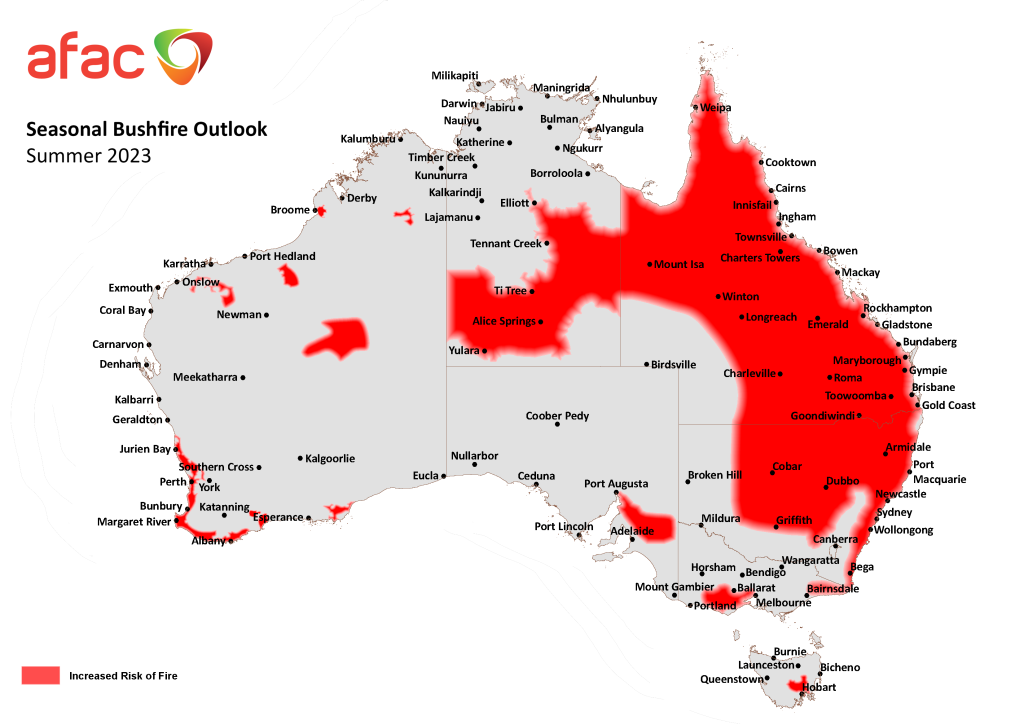High bushfire risks this summer, experts say

Emergency and health experts warn Australia is heading into the first of a series of high-risk bushfire seasons, as overlapping bushfire periods stretch resources.
Record-breaking dry conditions and warmer than average temperatures during early spring are behind the increased fire risk for large areas of Queensland, New South Wales and the Northern Territory, say Australasian Fire Authorities Council (AFAC) in their seasonal outlook for summer 2023.
Rob Webb, chief executive of AFAC, said the increased bushfire risk means it’s most important that people take action.
“Wherever you live, work or visit this summer, know where to find bushfire information, prepare your property, and talk to your family and friends about what you will do in an emergency,” he said.
“Australian fire agencies have had a busy start to the bushfire season, with many working in their communities and across state borders to respond to bushfires.”

Large parts of Australia have been classified as high risk in AFAC’s bushfire outlook. Photo: AFAC
Locations in Tasmania, Victoria, South Australia and Western Australia are also at increased risk of fire.
Longer seasons
Greg Mullins, a former Rural Fire Services commissioner and Climate Council councillor, said Australia’s bushfire seasons are becoming longer and starting earlier.
“The other thing operationally is that fire seasons overlap, so we can’t share aircraft and firefighters within Australia like we used to or internationally,” he said.
“Most of Queensland is at risk; there’s been another change that we’ve seen in tropical and subtropical regions that normally wouldn’t need to worry about fires except in the dry season.”
A change in weather patterns has decreased rainfall and increased ambient temperatures leading into the traditional bushfire season, resulting in AFAC warning on increased risk.
Mullins said the best action is to make communities more resilient and self-reliant.
“We need to find out what the real risks are and help communities come up with their own solutions, because on the worst days, they may not have any emergency services there,” he said.
“Humans have been digging up coal, oil and gas that was deposited over many hundreds of millions of years and in just 200 we’ve burned it and the atmosphere can’t cope, it’s warming up rapidly and we’re the ones who have to fix this.”
Health risks
Bushfires pose a risk to even those well away from the frontlines. Hundreds of people died because of smoke inhalation during the Black Summer bushfires in 2019-20.
Dr Kate Charlesworth, a public health physician and a councillor on the Climate Council, said Australia is on the frontline of climate-related health impacts.
“Just focusing in on extreme heat, which is one of the main concerns for this summer, there is now overwhelming scientific evidence that climate change is supercharging the climate,” she said.
“From the black summer bushfires, there were more than 400 deaths, more than 4000 hospitalisations and nearly $2 billion in healthcare costs just from the bushfire smoke.”
She said the most vulnerable people in society like the young, elderly, regional communities and people on low incomes are most at risk.
“Heatwaves are associated with a 12 per cent increase in death,” Charlesworth said.
“It will not be the wealthy people living in harbourside suburbs in big houses with air conditioning who die, it will be people out in Western Sydney who might be living on the top floor of social housing.”
Experts are predicting that the next two or three bushfire seasons will be high risk, and Mullins said high heat in 2023 could create even worse conditions in the future.
“2018 was eerily reminiscent of what we’re seeing now,” he said.
“We could be looking at another Black Summer in two years’ time.”








